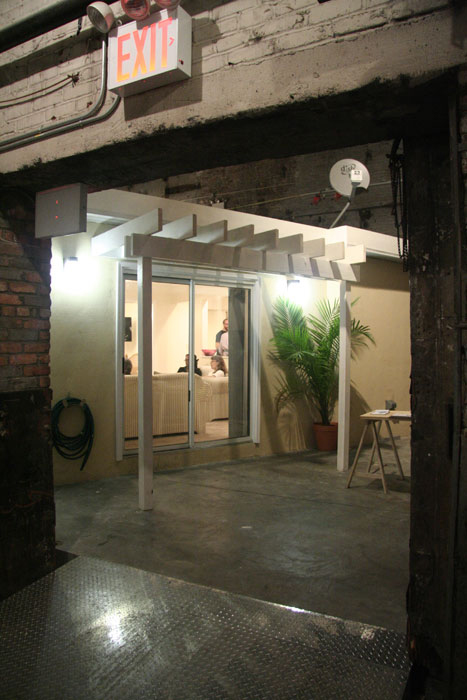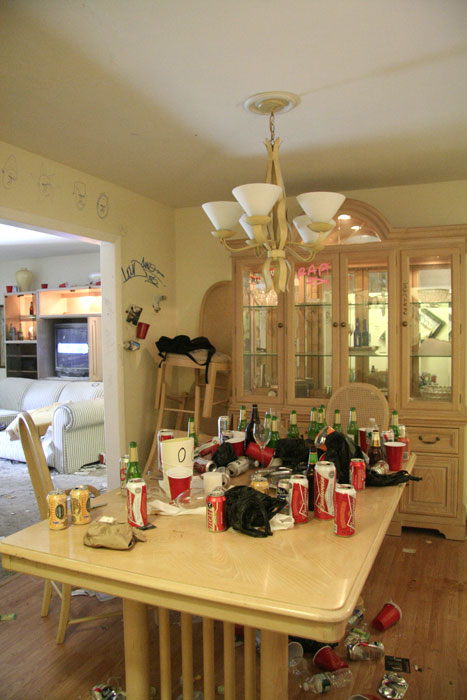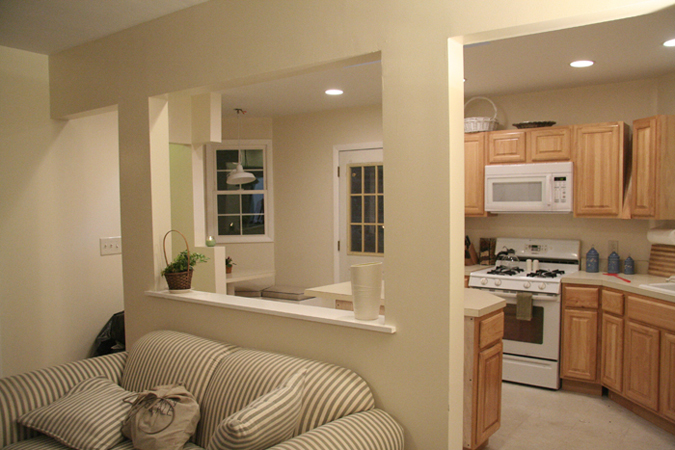House Party by Andrew Ohanesian at Pierogi / The Boiler Space
The House Party, Andrew Ohanesian, Pierogi/The Boiler by Nick Van Zanten
 The The House Party, Andrew Ohanesian’s “full-scale, participant activated installation” at Pierogi’s The Boiler space in Brooklyn is impressively effective in creating a displacement and a forum for discourse. The effect on the viewer is total, and achieves exactly what the artist aimed for, the teleporting citizens of the Brooklyn art scene back into suburban mainstream culture that they rejected in order to gain their present identities. Though intended mainly as a party, the piece also works when the party is over, and is well worth a visit during the daytime, when it is more open to contemplation and observation.
The The House Party, Andrew Ohanesian’s “full-scale, participant activated installation” at Pierogi’s The Boiler space in Brooklyn is impressively effective in creating a displacement and a forum for discourse. The effect on the viewer is total, and achieves exactly what the artist aimed for, the teleporting citizens of the Brooklyn art scene back into suburban mainstream culture that they rejected in order to gain their present identities. Though intended mainly as a party, the piece also works when the party is over, and is well worth a visit during the daytime, when it is more open to contemplation and observation.
The physical artwork consists of a house constructed inside The Boiler’s enormous industrial space. The house is as complete as necessary for the house party (no doorbell since you enter through the “backyard,” and the locked door to the parent’s bedroom has nothing behind it) and fully functional – while I was there I not only flushed the toilet and played music on the sound system, but was squirted with the lawn hose by another visitor. On top of that, the house has been fully stocked with fake artifacts of its occupants’ lives. Underneath the mattress in the teenage son’s room are Playboys, in his closet are trophies and a nearly empty tube of athlete’s foot cream, and a drawer in his desk was filled with what looked exactly like years of accumulated junk. Speaking with other visitors the only out of place item any of us could find was a bottle of boutique hot sauce. With the exception of that the piece was not only built like a tract house in the suburbs, but also stocked with the items denoting the culture that is prevalent there, in sharp contrast to its actual site in Williamsburg.
This house is primarily meant to be the setting of the real focus of the piece, a party held for the opening, which was repeated the day before I visited for the third anniversary of the blog Hyperallergic. At both parties the audience of New Yorkers fell completely into their roles as suburban partiers and trashed the place. When I saw it the day after the party the floors were strewn with empty bottles and the walls covered with graffiti. This destruction was encouraged, partly so that there would be a mark of the performance that had happened that could be seen during quieter gallery hours, but more importantly as a way to effect the audience into behaving as though the house and the party were authentically suburban. Curiously, the artist cleaned and fixed everything between the two parties – when I saw the piece, it had been destroyed again, but it is perfectly possible that it’s been put back to as clean as when mom and dad left town.
When I arrived there were already a number of visitors, gallery owners and artists from around Brooklyn. They offered me some scotch, and I stuck around for a few hours enjoying myself much as I might on a Saturday in such a house in the suburbs. It is a testament to how convinced we all were of our surroundings that the gallery sitter had to remind us multiple times that we could not smoke in the house (even with the screen door open) since the house was in fact inside a building in New York – this truth seemed stranger than the fiction of our being together in a suburban home. In this environment, our conversation turned again and again to the culture of capitalist consumerism, its façade of individualism that can be mimicked so easily by quoting cliché, and its irresponsible attitude as represented by the destruction of the house while its “owners,” the imaginary parents, were absent. We all seemed to recognize that our present identities were closely intertwined with the culture represented by the house, as we defined ourselves by our rejection of it and our negation of its place in our pasts.
 The conversation was wider ranging than that, and as visitors within the piece we considered all of our actions as participating with the artist in some way. Drinking, poking around drawers and bookshelves, and generally being lazy felt like encouraged forms of participation on a Saturday. We discovered a jigsaw puzzle and started putting it together, but ultimately left it for future visitors. One visitor proposed that we all get together and clean up the house, but this was decided to be too great an intervention on another artist’s piece. Another visitor read us the review that he was writing of the piece as we all sat in the living room, and we critiqued it. Generally, we simply discussed the piece itself and its implications, at length, though none of us knew one another. One person at the opening had intentionally broken the window on the front door, and we wondered whether this was a reaction against the fact that the piece was so convincing as to make one believe that you really were at a party in the suburbs, an illusion broken by seeing the industrial walls outside, or an action within that belief that would enable such destructive behavior. Clothing had been stolen out of closets, and trash strewn everywhere, and we sat discussing this. The piece succeeded in spontaneously causing destructive behavior at night, and the contemplation of that fact the next day.
The conversation was wider ranging than that, and as visitors within the piece we considered all of our actions as participating with the artist in some way. Drinking, poking around drawers and bookshelves, and generally being lazy felt like encouraged forms of participation on a Saturday. We discovered a jigsaw puzzle and started putting it together, but ultimately left it for future visitors. One visitor proposed that we all get together and clean up the house, but this was decided to be too great an intervention on another artist’s piece. Another visitor read us the review that he was writing of the piece as we all sat in the living room, and we critiqued it. Generally, we simply discussed the piece itself and its implications, at length, though none of us knew one another. One person at the opening had intentionally broken the window on the front door, and we wondered whether this was a reaction against the fact that the piece was so convincing as to make one believe that you really were at a party in the suburbs, an illusion broken by seeing the industrial walls outside, or an action within that belief that would enable such destructive behavior. Clothing had been stolen out of closets, and trash strewn everywhere, and we sat discussing this. The piece succeeded in spontaneously causing destructive behavior at night, and the contemplation of that fact the next day.
The work was effective on each level that it strived for: simply as an simulacrum of a suburban home it was so effective that, upon leaving, I found myself approaching the next few places I went as also being very convincing fakes. It succeeded as a site for discourse and critique of mainstream American culture, overcoming the geographic otherness that draws artists to Brooklyn by displacing such an effective object into a gallery there. And it seemed to have succeeded in getting the attendees of the reception to loose themselves in their roles as destructive adolescents, seeing the material existence around them as something to be used up and discarded for their own myopic pleasure without regard for its origins or greater meaning. In this case, what they were destroying was Ohanesian’s art, but it could just as easily have been their parents’ house.







Absolutely great project! Amazing review.